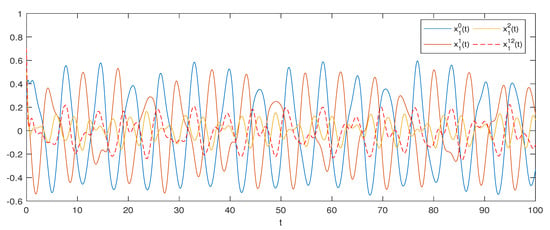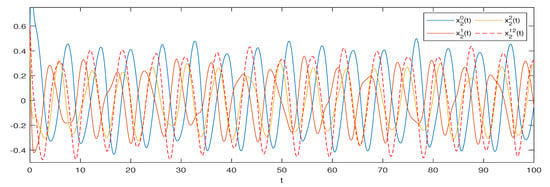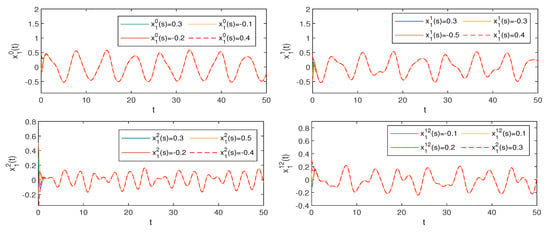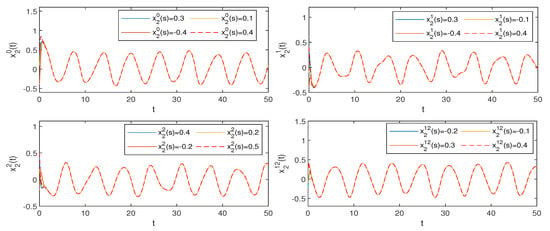Abstract
In this paper, Clifford-valued fuzzy neural networks with proportional delays, whose leakage term coefficients are also Clifford numbers, are considered. Based on the Banach fixed point theorem and differential inequality technique, we use a direct method to obtain the existence, uniqueness, and global attractivity of pseudo almost periodic solutions for the considered networks. Finally, we provide a numerical example to illustrate the feasibility of our results. Our results are new.
1. Introduction
The Clifford-valued neural network is a generalization of a real-valued neural network, complex-valued neural network, and quaternion-valued neural network, and has been shown superior to a real-valued neural network [1,2]. Because the multiplication of Clifford algebra does not meet the commutative law, there are few results on the dynamics of Clifford-valued neural networks [3,4,5,6,7,8,9,10,11]. Many existing results are obtained by decomposing a Clifford-valued system into a real-value system [3,4,5,6]. Therefore, it is a meaningful and challenging work to study the dynamics of Clifford-valued systems via a direct method; that is, without decomposing Clifford-valued systems into real-valued systems [7,8,9,10,11].
Since time delay is inevitable in modeling real systems, in recent years, as an important mathematical model, systems with proportional time delays play important roles in many application fields, such as physics, biological systems, neural network systems, and control science [12,13]. Therefore, many scholars have studied the dynamics of neural networks with proportional delays. For example, in [14], the existence and global attractiveness of pseudo almost periodic solutions for a class of fuzzy cellular neural networks with multiple proportional delays are obtained by using the fixed point theorem of contractive mapping and differential inequality technique, in [15], the existence, uniqueness, and exponential stability of anti-periodic solutions for recurrent neural networks with multiple delays are established by using the Lyapunov method and inequality technique. In [16], the finite time synchronization problem of a class of fuzzy cellular neural networks with time-varying coefficients and proportional delays is investigated. In [17], a class of competitive neural networks with multiple proportional delays is studied, and a new sufficient condition for the global exponential stability of such a network is obtained.
On the other hand, in the mathematical modeling of practical problems, uncertainty or fuzziness is a factor to be considered. On the basis of traditional cellular neural networks, fuzzy cellular neural networks [18] were first proposed in 1996. They are neural networks that incorporate fuzzy logic into the structure of traditional cellular neural networks. They have important applications in image processing and pattern recognition; therefore, fuzzy neural networks have been widely studied [14,15,16,17,18,19,20,21].
In addition, almost periodic oscillation and pseudo almost periodic oscillation are important dynamics of neural networks. Many authors have studied the existence and stability of almost periodic solutions [5,13] and pseudo almost periodic solutions [22,23,24,25,26] of neural networks, including stochastic neural networks [27] and fuzzy neural networks [28,29].
Moreover, recently, the existence and global exponential stability of -pseudo almost periodic solutions to a class of Clifford-valued higher order Hopfield neural networks, with bounded multiple discrete delays whose leakage term coefficients are also Clifford numbers, is studied in [30]. Proportional delays are a class of unbounded delays. Neural networks with proportional delays are a class of neural networks with important theoretical and application values. However, up until now, the results of almost periodic oscillation of neural networks with proportional delays and whose leakage term coefficients are also Clifford numbers, have not been reported.
Inspired by the above analysis, the purpose of this paper is to study the existence and attraction of pseudo almost periodic solutions for a class of Clifford-valued fuzzy neural networks with proportional delays and whose leakage term coefficients are also Clifford numbers. To the best of our knowledge, this is the first paper to study the existence and attractivity of pseudo almost periodic solutions of Clifford-valued neural networks with proportional delay and whose leakage coefficients are also Clifford numbers.
The rest of the paper is arranged as follows. In Section 2, we review some concepts, introduce some lemmas, and give the model’s description. In Section 3, by using the direct method, we establish the existence of pseudo almost periodic solutions for the network under consideration. In Section 4, we study the global attractivity of pseudo almost periodic solutions. In Section 5, we give a numerical example to illustrate the feasibility of our results. Finally, we draw a brief conclusion in Section 6.
2. Model Description and Preliminaries
The real Clifford algebra over is defined as
where , for , . In addition, and are said to be Clifford generators and satisfy , , , where .
For , we define and for , we define , then and are Banach spaces. For , we define and .
According to [19], for , we define
where
The model we want to study in this paper is as follows:
where n is the number of neurons in layers, represents the state of the ith unit at time t, is a Clifford algebra; is the rate with which the ith unit will reset its potential to the resting state in isolation when disconnected from the network and external inputs; correspond to the first-order and second-order connection weights of the fuzzy neural network; is the fuzzy feedback MAX template; is the fuzzy feedback MIN template; and are the fuzzy feed-forward MAX template and the fuzzy feed-forward MIN template; is the input of the jth neuron; stands for the external inputs; are the activation functions; is the proportional coefficient of proportional delay.
For convenience, we will adopt the following notations:
The initial values of system (1) are given by
where .
Let be the collection of all bounded and continuous functions from to . The space is a Banach space when it is endowed with the norm:
where .
Definition 1
([20]). A function is called to an almost periodic function, if for every , there exists such that for each interval with length , one can find a number satisfying
All of these functions will be denoted by .
Definition 2
([20]). A function is said to be pseudo almost periodic, if it can be written as , where , and
Lemma 1
([20]). If , then .
Lemma 2
([20]). Let satisfy the Lipschitz condition and , then .
Lemma 3
( [21]). If , , , then .
Using the same proof method as Lemma 2 in [14], we can prove
Lemma 4.
Assume that , then we have .
Lemma 5
([20]). The space is a Banach space.
Similar to the proof of Corollary 1 in [18], one can easily show that
Lemma 6.
If . Then we have
Lemma 7
([20]). Let , where with and , then .
The assumptions used in this paper are as follows:
- (H1)
- For with ,,.
- (H2)
- For , functions satisfy there exist constants, such that for any ,and
- (H3)
- The constant
3. Pseudo Almost Periodic Solutions
In this section, by the contracting mapping principle, we will study the existence of pseudo almost periodic solutions of (1).
For , we define
Let and
Define
where is mentioned in (H3) and N is a positive constant satisfying , then we have
Theorem 1.
If assumptions (H1)–(H3) hold, then system (1) has a unique pseudo almost periodic solution in .
Proof.
Consider the mapping defined by setting , , where
By Lemmas 1–4, we obtain . Further, by Lemma 7, we have .
We will divide the rest of the proof into two steps.
Step 1, we will verify is a self-mapping. For any , we have
Hence, .
Step 2, we will show T is a contractive mapping. For any , we find
Noticing that , T is a contracting mapping. Therefore, system (1) possesses a unique one pseudo almost periodic solution in . This completes the proof. □
4. Global Attractivity
Our result on the global attractivity of pseudo almost periodic solutions of system (1) is as follows:
Theorem 2.
Proof.
If is the pseudo almost periodic solution of system (1) with initial value and y is an arbitrary solution of system (1) with the initial value . Let Then, for , one gets
From (H3), for , we have
Let be defined by
where . Then, from (3), we have
Since , as and the continuity of , we can take a constant , such that and
Noting that
for any , we have that
We claim that
To prove (4) holds, we will prove for every , the following inequality holds.
If (5) does not hold, then there must be some , such that
which combined with (2), for , we have
this yields that,
which contradicts (6). Hence, (5) holds. Letting , we derive that (4) holds. The proof is complete. □
5. An Example
Our numerical example is as follows.
Example 1.




By a simple calculation, we have
Besides, we can get
and . Hence, conditions (H1)–(H3) of are verified. Consequently, by Theorem 2, system (1) possesses a unique one pseudo almost periodic solution that is globally attractive (see Figure 1, Figure 2, Figure 3 and Figure 4).

Figure 1.
The states of (1) with different initial values.

Figure 2.
The states of (1) with different initial values.

Figure 3.
The stability of states of (1) with different initial values.

Figure 4.
The stability of states of (1) with different initial values.
Remark 1.
No known results can be used to draw the conclusion of Example 1.
6. Conclusions
In this paper, we studied the existence and global attractivity of pseudo almost periodic solutions for a class of Clifford-valued fuzzy neural networks with proportional delays whose leakage coefficients were also Clifford numbers by the direct method. Our results are new. Our method can be used to study the existence and attractivity of pseudo almost periodic solutions for other types of Clifford-valued neural networks with proportional delays, and to study the existence and attractivity of almost automorphic solutions of Clifford-valued neural networks with proportional delays.
Author Contributions
Conceptualization, B.L.; Investigation, W.L. and B.L.; Supervision, B.L.; Writing—original draft, W.L. and B.L.; Writing—review and editing, B.L. All authors have read and agreed to the published version of the manuscript.
Funding
This work is supported by the Applied Basic Research Foundation of Yunnan Province under Grant No. 2019FB003.
Institutional Review Board Statement
Not applicable.
Informed Consent Statement
Not applicable.
Data Availability Statement
Not applicable.
Conflicts of Interest
The authors declare no conflict of interest.
References
- Buchholz, S. A Theory of Neural Computation with Clifford Algebras. Ph.D. Thesis, University of Kiel, Kiel, Germany, 2005. [Google Scholar]
- Buchholz, S.; Sommer, G. On Clifford neurons and Clifford multi-layer perceptrons. Neural Netw. 2008, 21, 925–935. [Google Scholar] [CrossRef]
- Liu, Y.; Xu, P.; Lu, J. Global stability of Clifford-valued recurrent neural networks with time delays. Nonlinear Dyn. 2016, 84, 767–777. [Google Scholar] [CrossRef]
- Zhu, J.; Sun, J. Global exponential stability of Clifford-valued recurrent neural networks. Neurocomputing 2016, 173, 685–689. [Google Scholar] [CrossRef]
- Li, Y.; Xiang, J. Global asymptotic almost periodic synchronization of Clifford-valued CNNs with discrete delays. Complexity 2019, 2019, 6982109. [Google Scholar] [CrossRef]
- Huo, N.; Li, B.; Li, Y. Anti-periodic solutions for Clifford-valued high-order Hopfield neural networks with state-dependent and leakage delays. Int. J. Appl. Math. Comput. Sci. 2020, 30, 83–98. [Google Scholar]
- Li, Y.; Huo, N.; Li, B. On μ-pseudo almost periodic solutions for Clifford-valued neutral type neural networks with delays in the leakage term. IEEE Trans. Neural Netw. Learn. Syst. 2021, 32, 1365–1374. [Google Scholar] [CrossRef] [PubMed]
- Li, Y.; Shen, S. Pseudo almost periodic synchronization of Clifford-valued fuzzy cellular neural networks with time-varying delays on time scales. Adv. Differ. Equ. 2020, 2020, 593. [Google Scholar] [CrossRef]
- Li, Y.; Li, B. Pseudo compact almost automorphy of neutral type Clifford-valued neural networks with mixed delays. Discrete Contin. Dyn. Syst.-B 2021, in press. [Google Scholar] [CrossRef]
- Aouiti, C.; Dridi, F.; Hui, Q.; Moulay, E. (μ,ν)-pseudo almost automorphic solutions of neutral type Clifford-valued high-Order Hopfield neural networks with D Operator. Neural Process. Lett. 2021, 53, 799–828. [Google Scholar] [CrossRef]
- Aouiti, C.; Dridi, F. Weighted pseudo almost automorphic solutions for neutral type fuzzy cellular neural networks with mixed delays and D operator in Clifford algebra. Int. J. Syst. Sci. 2020, 51, 1759–1781. [Google Scholar] [CrossRef]
- Liu, Y. Asymptotic behavior of functional differential equations with priportional time delays. Eur. J. Appl. Math. 1996, 7, 11–30. [Google Scholar] [CrossRef]
- Huang, Z. Almost periodic solutions for fuzzy cellular neural networks with multi-proportional delays. Int. J. Mach. Learn. Cyber. 2017, 8, 1323–1331. [Google Scholar] [CrossRef]
- Liang, J.; Qian, H.; Liu, B. Pseudo almost periodic solutions for fuzzy cellular neural networks with multi-proportional delays. Neural Process. Lett. 2018, 48, 1201–1212. [Google Scholar] [CrossRef]
- Huang, C.; Long, X.; Cao, J. Stability of antiperiodic recurrent neural networks with multiproportional delays. Math. Meth. Appl. Sci. 2020, 43, 6093–6102. [Google Scholar] [CrossRef]
- Wang, W. Finite-time synchronization for a class of fuzzy cellular neural networks with time-varying coefficients and proportional delays. Fuzzy Sets Syst. 2018, 338, 40–49. [Google Scholar] [CrossRef]
- Qin, J.; Li, Y. New results on exponential stability of competitive neural networks with multi-proportional delays. Asian J. Control 2020, 22, 750–760. [Google Scholar] [CrossRef]
- Yang, T.; Yang, L.; Wu, C.; Chua, L. The global stability of fuzzy cellular neural network. IEEE Trans. Circ. Syst. I 1996, 43, 880–883. [Google Scholar] [CrossRef]
- Shen, S.; Li, Y. Sp-almost periodic solutions of Clifford-valued fuzzy cellular neural networks with time-varying delays. Neural Process. Lett. 2020, 51, 1749–1769. [Google Scholar] [CrossRef]
- Li, B.; Li, Y. Existence and global exponential stability of pseudo almost periodic solution for Clifford-valued neutral high-order Hopfield neural networks with leakage delays. IEEE Access 2019, 7, 150213–150225. [Google Scholar] [CrossRef]
- Yu, Y. Exponential stability of pseudo almost periodic solution for cellular neural networks with multi-proportional delays. Neural Process. Lett. 2017, 45, 141–151. [Google Scholar] [CrossRef]
- Meng, X.; Li, Y. Pseudo almost periodic solutions for quaternion-valued high-order Hopfield neural networks with time-varying delays and leakage delays on time scales. AIMS Math. 2021, 6, 10070–10091. [Google Scholar] [CrossRef]
- Huang, C.; Liu, B.; Qian, C.; Cao, J. Stability on positive pseudo almost periodic solutions of HPDCNNs incorporating D operator. Math. Comput. Simul. 2021, 190, 1150–1163. [Google Scholar] [CrossRef]
- Arbi, A. Dynamics of BAM neural networks with mixed delays and leakage time-varying delays in the weighted pseudo-almost periodic on time-space scales. Math. Meth. Appl. Sci. 2018, 41, 1230–1255. [Google Scholar] [CrossRef]
- Tang, Y. Pseudo almost periodic shunting inhibitory cellular neural networks with multi-proportional delays. Neural Process. Lett. 2018, 48, 167–177. [Google Scholar] [CrossRef]
- Kong, F.; Fang, X. Pseudo almost periodic solutions of discrete-time neutral-type neural networks with delays. Appl. Intell. 2018, 48, 3332–3345. [Google Scholar] [CrossRef]
- Li, Y.; Wang, X. Almost periodic solutions in distribution of Clifford-valued stochastic recurrent neural networks with time-varying delays. Chaos Solitons Fractals 2021, 153, 111536. [Google Scholar] [CrossRef]
- Aouiti, C.; Gharbia, I.B. Piecewise pseudo almost-periodic solutions of impulsive fuzzy cellular neural networks with mixed delays. Neural Process. Lett. 2020, 51, 1201–1225. [Google Scholar] [CrossRef]
- Tang, Y. Exponential stability of pseudo almost periodic solutions for fuzzy cellular neural networks with time-varying delays. Neural Process. Lett. 2019, 49, 851–861. [Google Scholar] [CrossRef]
- Li, Y.; Huo, N. (μ,ν)-pseudo almost periodic solutions of Clifford-valued high-order HNNs with multiple discrete delays. Neurocomputing 2020, 414, 1–9. [Google Scholar] [CrossRef]
Publisher’s Note: MDPI stays neutral with regard to jurisdictional claims in published maps and institutional affiliations. |
© 2021 by the authors. Licensee MDPI, Basel, Switzerland. This article is an open access article distributed under the terms and conditions of the Creative Commons Attribution (CC BY) license (https://creativecommons.org/licenses/by/4.0/).